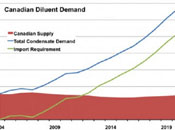
Macquarie Equities Research said in a client note several days ago that energy efficiency measures really do seem to be having an impact on electricity demand, and the effect is likely to continue. It's not just theoretical or wishful, the analysts said. "Unfortunately for investors," the firm said, "utilities expect this demand destruction to continue or even accelerate."
A couple of electric utilities said pretty much the same thing.
According to a Macquarie survey of utilities, to which 43 responded, most expect slow demand growth, less than 1% a year, significantly less than the historical rate of about 2%. The economy is partly to blame for flat or small growth in demand over the last several years — and some respondents see the economy as the bigger driver — but "more than half of utilities estimate that energy efficiency has reduced their load growth by up to 1% per annum, with nearly an additional quarter estimating a reduction of up to 0.5%." Eighty-one percent see efficiency's impact having picked up since about 2007.
(Conservation is another matter, Macquarie notes. Efficiency measures are things that get built into systems; conservation is behavior, and utilities see conservation behavior being strongly driven by the economy, and thus only temporary.)
By coincidence, Xcel Energy and American Electric Power executives talked about the same thing in presentations at Merrill Lynch's Power and Gas Leaders Conference last week. According to them, improved appliance efficiency and new building codes are making a dent in load growth.
Ben Fowke, Xcel's chairman and chief executive, said that while economic issues may be weighing down commercial and industrial sales, major improvements in home appliances may be holding down residential power sales. "Technology is really getting better. I think it's a trend we're really going to watch," he said. According to Fowke, Xcel's efficiency programs are dampening demand about 0.7%.
Likewise, Brian Tierney, AEP's CFO, said stricter appliance and building code standards are having an impact. And changes that have been made by the industrial sector are beginning to appear in the commercial and residential sectors, he said.
"It's a very difficult time to forecast load growth," said Art Beattie, Southern Company's CFO. His utilities have seen sluggish commercial-sector growth, which Beattie suggested could be affected by the growing amount of online commerce (not energy efficiency … though some might well say so.)
Separately, Glenrock Associates analyst Paul Patterson, talking about Maryland and what he describes as its extremely aggressive demand-reduction goals, said the state's utilities "may not be able to achieve the goals, but even if they are partially successful it has huge ramifications for the power sector."
"It is unclear if we're in a new paradigm or not," Patterson said, "but it doesn't bode well" for the industry. "It has the potential to change the profit trajectory."
The upshot for the power sector, the Macquarie analysts said, is postponement of the need for new supply. "Slow load growth should hurt near-term earnings and may drive more frequent rate case filings and/or postpone the need for generation/transmission capex for regulated utilities." Regulated companies may have rate programs that protect them from sales declines attributable to efficiency measures. But for merchants–unregulated power companies–the weak load growth would be continued bad news. Macquarie says it could delay the tightening of power markets that would otherwise be expected to happen as lots of coal plants retire because of environmental regulations and the continuing low price of natural gas.
Patterson agreed. "It might be a bad cold for utilities, but for merchant generators, it could be a heart attack."
Macquarie sees annual load growth of only 0.4% to 0.6% over the long term, less than most companies' projections, the analysts said.
Another conclusion Macquarie draws from the load growth figures is decreasing correlation between power demand and GDP. These two historically have fallen and risen roughly in tandem, but started to "decouple" sometime last year, and energy efficiency is contributing to that. And although 58% of utilities have at least tried to adjust their weather-normalization models for energy efficiency and conservation, "comments indicate that the process is 'very difficult'," Macquarie said.
Kathy Larsen
Platts























































